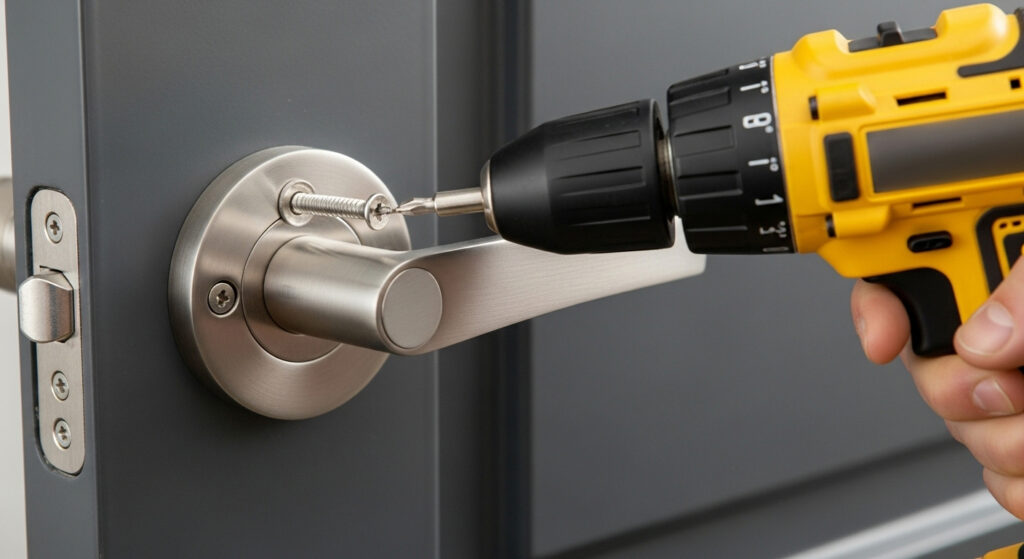About This Guide: Tips for Preventing Lock Freezing in Cold Weather
When temperatures plunge, moisture sneaks into cylinders, condenses, and freezes—turning a simple doorway into a stubborn block of ice. Frozen locks are inconvenient, but they also invite damage: bent keys, broken cylinders, cracked handles, and doors slammed hard enough to misalign strikes and latches. This guide gathers practical, field-tested tips for preventing lock freezing in cold weather, so your doors, vehicles, gates, and padlocks keep working when the forecast doesn’t cooperate.
The secret is prevention. If you keep water out, reduce condensation, and maintain clean, lightly lubricated hardware, you’ll avoid most freeze-ups. We’ll cover smart moisture control, cold-ready lubricants, protective hardware upgrades, daily routines that actually help, and safe emergency techniques if a lock does ice over. You’ll also find a simple winterization checklist you can run through in under an hour.
Whether you manage a home entry, a bank of office doors, rental properties, or a yard full of outdoor padlocks, the same principles apply: block the water pathways, control temperature swings, and keep the mechanism clean. Done right, your locks will feel ordinary even on the coldest mornings—no torch drama, no snapped keys, and no last-minute locksmith calls.
Core Strategies to Stop Locks From Freezing
Use these building blocks together for the best cold-weather reliability.
Keep Moisture Out of the Keyway
Water is the culprit. Fit exterior cylinders with weather shrouds or flip-down dust covers, and add a tight face gasket where possible. For padlocks, choose models with covered keyways and drainage channels. If you can’t change hardware before winter, tape a temporary flap over seldom-used keyholes to block wind-driven snow.
Use Cold-Friendly, Low-Residue Lubricants
Avoid heavy oils that thicken in the cold and attract grit. Prefer a dry graphite or PTFE (dry film) in the keyway and a micro-drop of light synthetic oil only on visible pivots/hinges. Wipe all excess. A clean, dry cylinder gives ice fewer places to grab.
Start Winter With a Clean Cylinder
Dirt absorbs moisture. Before the first freeze, blow out debris with a hand air bulb, brush the keyway gently, and relubricate lightly. On padlocks, rinse off road salt with a damp cloth and dry fully before re-lube to prevent internal corrosion and ice nucleation.
Choose Weather-Resistant Hardware
Where possible, use cylinders and padlocks designed for exterior duty: shielded keyways, tight tolerances, sealed shackle wells, and drainage. For gates and sheds, position locks under a small hood or awning to reduce direct snow/rain exposure.
Adopt a Cold-Weather Routine
Keep one de-icer and one dry lube by each main door. After wet days, lock/unlock each exterior door once in the evening to expel residual moisture, then re-lube lightly if action feels sticky. Don’t leave damp keys in the cylinder overnight.
Provide an Ice-Proof Backup
Keypads or smart readers on high-traffic doors reduce keyway use during storms. If you rely on keys only, keep a weather-sheltered lock box with a duplicate, and store de-icer where you can reach it without unlocking anything else.
Why Locks Freeze (and Common Mistakes)
Understanding failure modes helps you prevent them efficiently.
-
Condensation Inside the Cylinder
Warm keys inserted after being in a pocket can bring moisture into a cold cylinder; it condenses and later freezes. Solution: keep keys dry, insert/remove promptly, and avoid breathing onto the keyhole in extreme cold.
-
Wind-Driven Snow and Rain
Storms push moisture directly into unprotected keyways. Solution: add dust covers or shrouds; reorient padlocks so the keyway points down or sideways to minimize ingress.
-
Wrong Lubricant
Heavy oils gum up and capture water; many water-displacing sprays aren’t suitable as long-term lubes. Solution: clean and switch to graphite/PTFE; reserve a tiny drop of synthetic oil for exposed pivots only.
-
Force and Heat Misuse
Twisting harder snaps keys; open flames scorch finishes and damage seals. Solution: use chemical de-icer or controlled warmth (body heat, warm—not boiling—water on the key only, then dry).
-
Salt and Road Grime
De-icing salts corrode internals and retain moisture. Solution: periodically wipe padlocks and gate hardware, rinse with fresh water, dry thoroughly, and re-lube lightly.
Benefits of a Freeze-Prevention Plan
Reliability
Doors and padlocks operate normally, even after sleet or sudden cold snaps.
Lower Repair Costs
Clean, dry cylinders avoid bent keys, cracked faces, and emergency replacements.
Faster Mornings
No more chipping ice while you’re late for work—one motion, and you’re inside.
Longer Hardware Life
Less corrosion and abrasion means cylinders, latches, and padlocks last more seasons.
Step-by-Step: Winterize Your Locks in One Hour
1) Gather supplies: dry graphite or PTFE spray, a hand air bulb, microfiber cloths, cotton swabs, light synthetic oil, de-icer, masking tape, and small dust covers (or weather shrouds if upgrading). Optional: a small awning or hood for exposed gates.
2) Clean exterior hardware. Wipe away grime and salt from escutcheons, levers, and padlock bodies. Use a damp cloth, then dry completely—trapped moisture is the enemy.
3) Clear the keyway. Use the air bulb to puff out debris; never blast high-pressure canned air that can introduce propellant. Gently brush the keyway slit to remove packed dust.
4) Apply a dry lubricant. One or two short puffs of graphite or a light PTFE dry film into the keyway is enough. Insert the key and cycle the lock several times to distribute. Wipe any excess from the face.
5) Treat hinges and visible pivots. Place a tiny drop of light synthetic oil on door hinges and exposed latch pivots, then wipe the surplus. Do not flood the cylinder; the keyway should remain essentially dry.
6) Add protection. Install dust covers or shrouds on exterior cylinders. For padlocks, orient the keyway down and consider a rubber cap. If an upgrade isn’t possible, use a neat tape flap as a temporary wind shield on rarely used locks.
7) Stage emergency supplies. Place one de-icer and one dry lube in a sheltered spot you can access without unlocking another door. Keep a duplicate house key in a weather-proof lock box in case your main cylinder freezes during a storm.
8) Train your routine. After wet days, cycle each exterior lock once in the evening, then remove the key. Don’t leave damp keys inserted; pocket moisture can condense in the plug and freeze overnight.
Cold-Weather Gear & Helpful Upgrades
Small investments that pay off all winter.
Weather Shrouds & Dust Covers
Clip-on or integrated covers shield keyways from wind and sleet, reducing water intrusion dramatically.
Dry Lubricants
Graphite or PTFE dry films keep tolerances free without gumming; ideal for cold climates and outdoor cylinders.
Cold-Rated Padlocks
Look for sealed shackle wells, covered keyways, and drain paths. Stainless or brass bodies resist corrosion from salt.
Small Awnings or Hoods
Over doorways and gates, a modest visor cuts wind-blown precipitation and prolongs hardware life.
Keyless Options
On high-traffic entries, keypads or readers eliminate keyway exposure. Keep a physical backup in case of power/battery issues.
De-icer (Emergency Use)
Keep a lock-safe de-icer on hand. Use it sparingly, then dry-lube at the next opportunity to restore low-residue protection.
If a Lock Freezes: Safe Emergency Techniques
Unfreeze gently to avoid damage—then prevent the next freeze-up.
-
Warm the Key, Not the Lock
Warm the key in your hands or with a pocket warmer and insert it slowly; the heat transfers to the plug. Avoid pouring hot water on the lock body—that refreezes and adds more moisture.
-
Use a Lock-Safe De-icer
Apply a small amount into the keyway, wait a moment, and gently turn the key. Once open, dry the face and reapply a dry lube to restore protection.
-
No Open Flames
Torches can scorch finishes, melt seals, and even ignite vapors. Stick to chemical de-icer or controlled warmth.
-
Realign Before You Force
On doors, slight frame swell can bind the bolt. Pull or push the door to relieve pressure, then try again. If the key will not turn with light pressure, stop—excess force snaps keys.
Daily & Weekly Cold-Weather Habits
Small routines keep hardware dependable through the season.
After Precipitation
Cycle each exterior lock once in the evening to expel moisture, then dry the face.
Weekly Five-Minute Check
Inspect for salt buildup, wipe padlocks, test action, and top up dry lube if operation feels scratchy.
Key Discipline
Keep keys dry and separate from snow-wet gloves; avoid breathing into the keyway on very cold mornings.
Spare Management
Store duplicates indoors in a dry place; rotate sets so one ring isn’t always exposed to salt and slush.
Quick Winterization Checklist
- Clean cylinder faces and padlock bodies; dry fully.
- Blow out keyways with a hand air bulb; brush gently.
- Apply graphite or PTFE dry lube; cycle keys several times.
- Oil hinges and exposed pivots sparingly; wipe excess.
- Install dust covers or shrouds; orient padlock keyways down.
- Stage de-icer and dry lube somewhere you can reach without unlocking.
- Adopt an evening cycle-and-dry routine after wet weather.
FAQ
Can I use household de-icers or salt water? Avoid salt solutions; they corrode internals and attract moisture. Use a product intended for locks and re-lube dry afterward.
Is WD-type spray good for winter? It can displace moisture short-term but is not ideal as a long-term lubricant. Prefer graphite/PTFE in the keyway for cold climates.
What about silicone sprays? Some silicone sprays leave residues that attract dust. If used, apply lightly and follow with a dry film lube when practical.
Should I cover every exterior lock? Prioritize wind-exposed doors, gates, and any cylinder facing sideways or upward. Padlocks benefit most from covered keyways and proper orientation.
Do smart locks solve freezing? They reduce keyway use, but exposed mechanical parts can still freeze. Choose weather-rated models and keep a physical backup plan.
Winter – Proof Your Entry Points Today
Clean, dry, protect—then keep a simple routine. If a lock repeatedly freezes or feels gritty even after care, it may be time for a weather-rated upgrade or a professional inspection. A few preventive steps now will save keys, cylinders, and a lot of cold-weather frustration.

